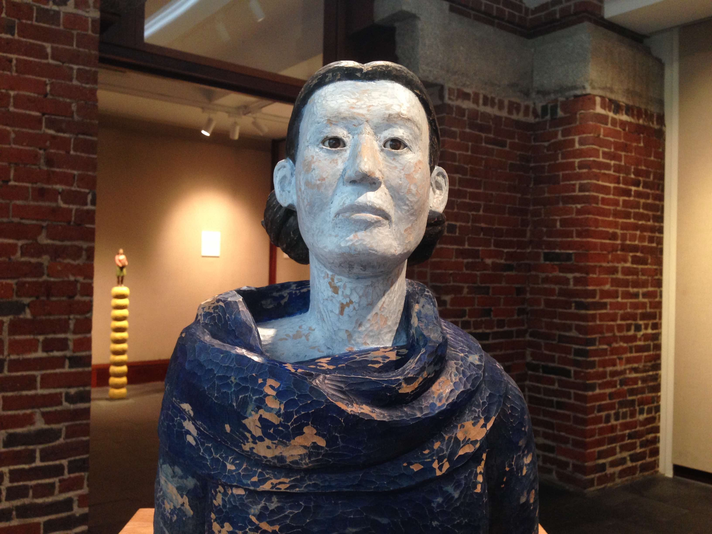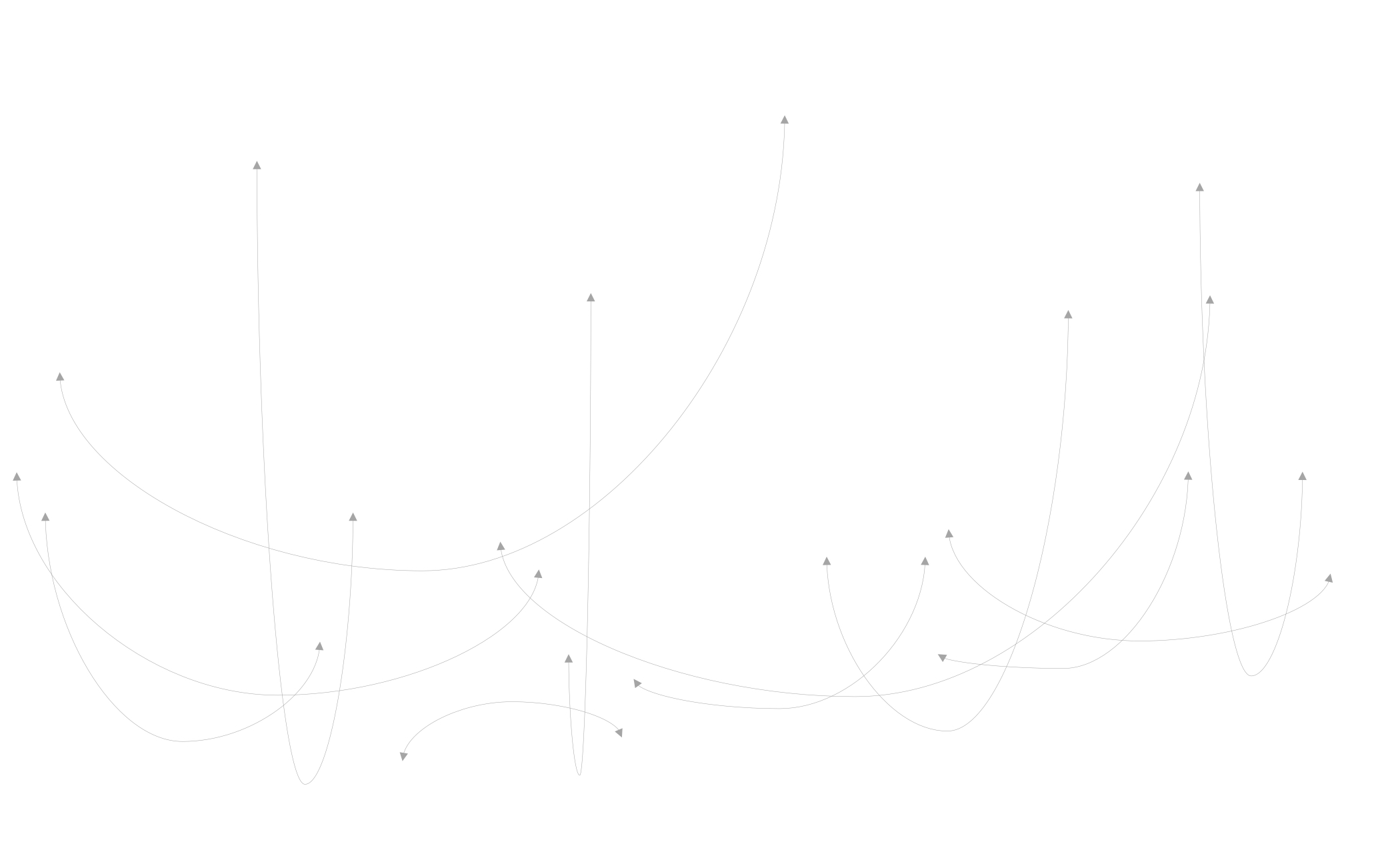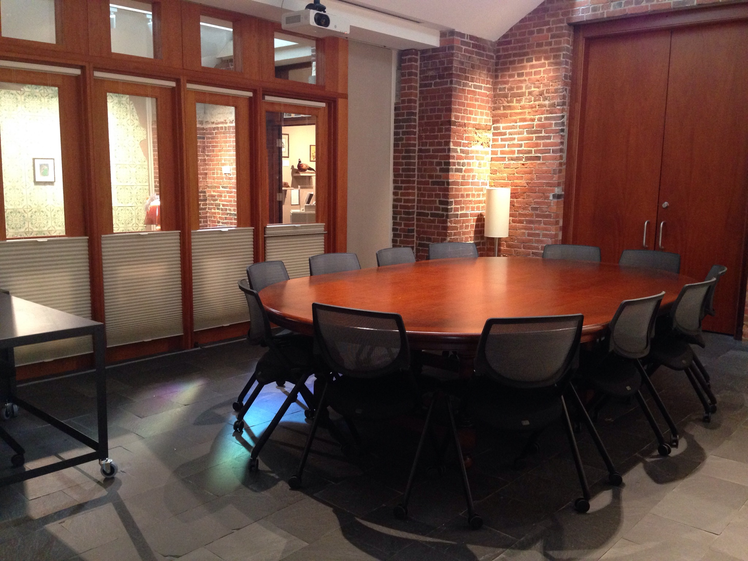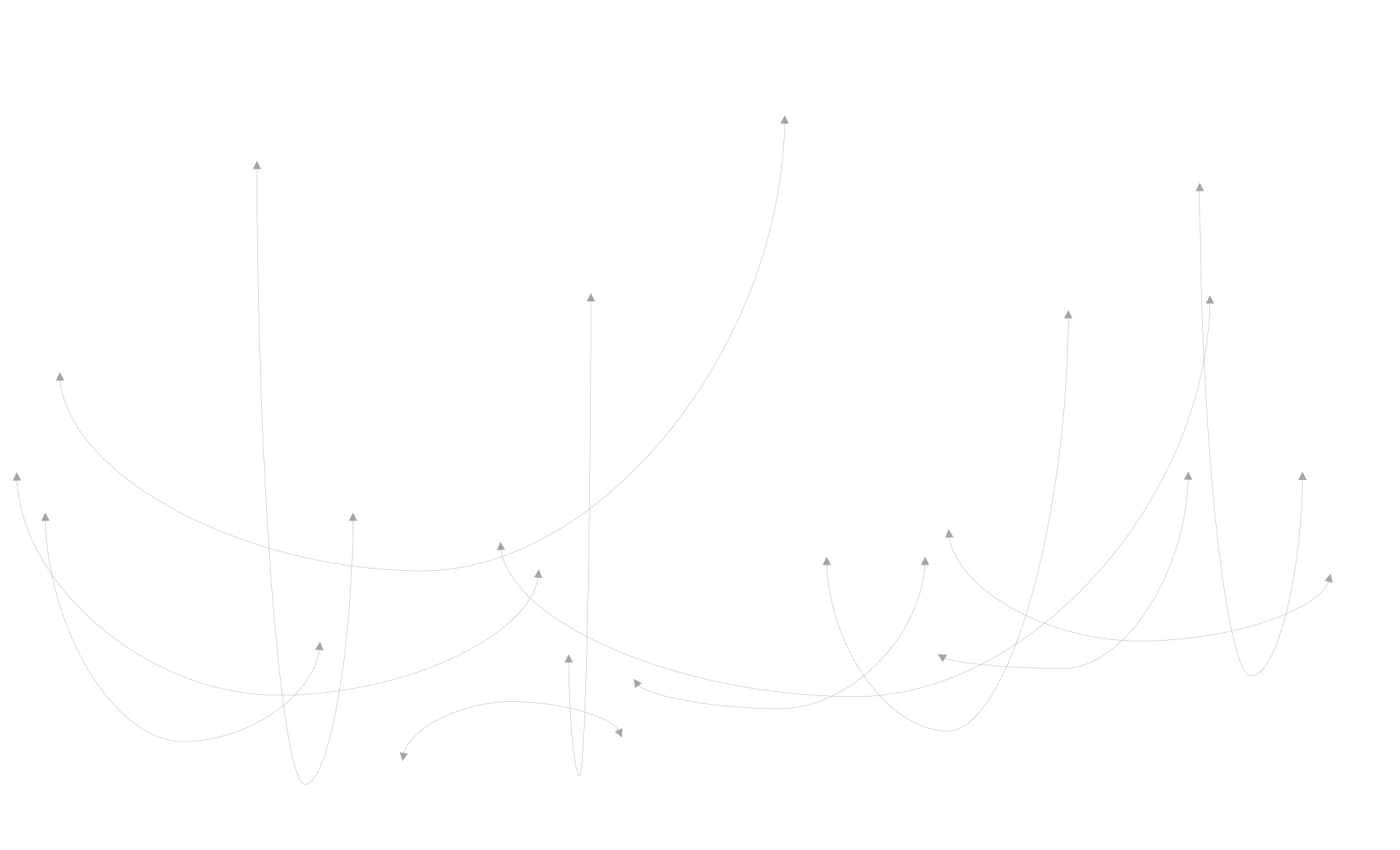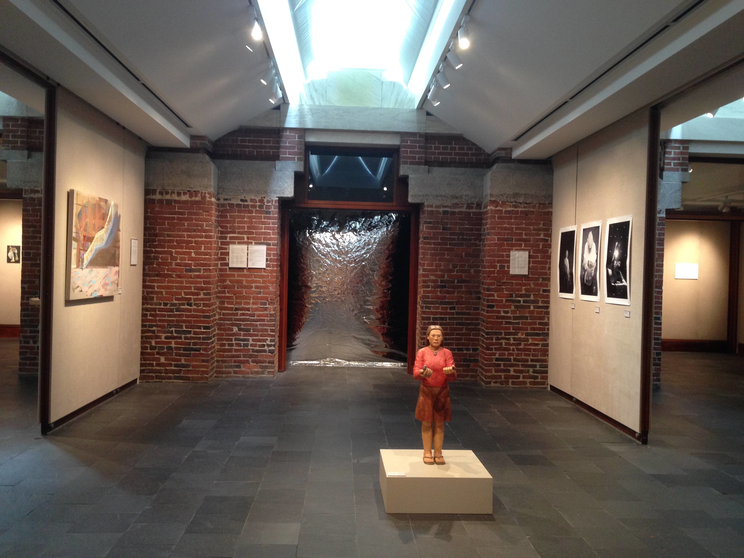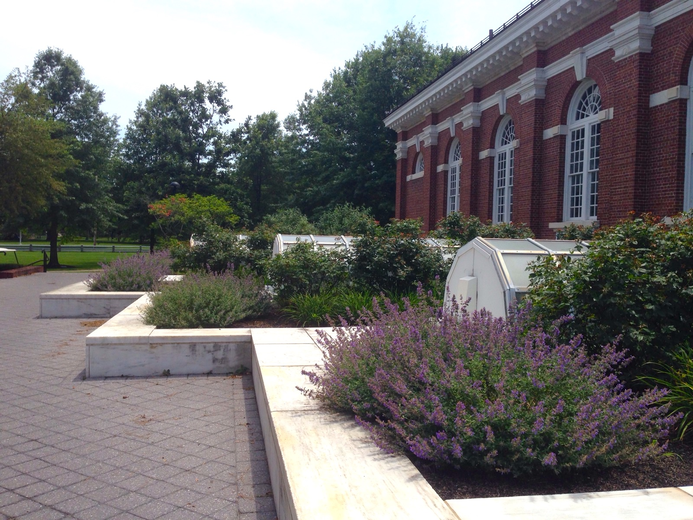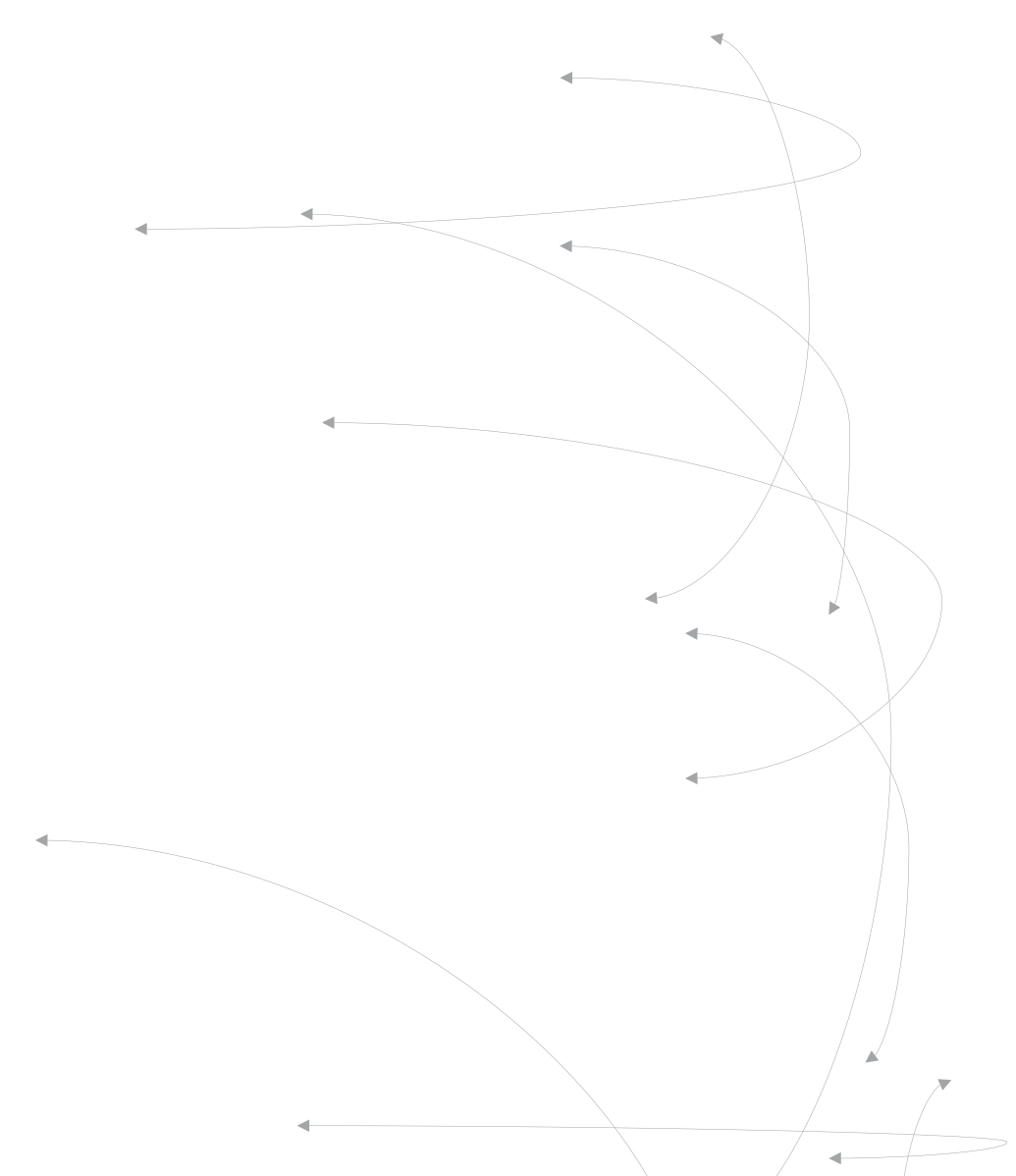On the Museum Floor
An influential experience with moving and talking in the gallery was during my first museum position at the Computer Museum in Boston. As part of an exhibition development team, I developed a comprehensive evaluation plan for an exhibition. I considered design elements, such as seating, wayfinding, and signage, as well as interactive software. I spent a lot of time on the museum floor watching how people interacted with exhibitions and with each other. In an area called the “Test Tube,” we prototyped aspects of the exhibition. We piloted beta versions of software and fabricated different types of seating and other displays. While some of the evaluation took place through observing and tracking people's behavior, the most enjoyable aspects of the process were through direct conversations with the audience.
Although I was unaware of it at the time, I was prototyping a method that would become an intentional element of my later work as a curator. My approach was influenced by my long engagement with somatic and movement practices, too. Moving in a space, in dialogue with self and others, is a way to come to know something.
Now, I spend a great deal of time walking, talking, and moving objects around within the exhibition space—this is choreographic thinking in practice. The implications for artistic research in the curatorial realm or any other cultural setting is that for me, the "expertise" is never developed, or practiced, in isolation or in stillness. It is always contingent, dialogic, and in motion.
On the Path
Fast forward to my work at the Lamont Gallery.
One of the most generative forms of choreographic thinking in my curatorial practice is through conversations with colleagues, students, and audience members that happen through moving, making, and experiencing. This practice has shaped my curatorial practice in a way that would not have been the case if we were having conversations across a desk in an office.
There was no one speed or tenor of a conversation. It could begin, be interrupted, picked up again the next day. It could be leisurely. It could be task-oriented or exploratory. With or without refreshments. Sitting, standing, arriving, or departing. While the point of the conversations was not to produce the thing or commit to it, the idea and energy the conversation generated was enough to initiate other movements of thought and action upon my return to the gallery.
Conversations often occurred while traversing the Phillips Exeter Academy’s campus, where the Lamont Gallery is located. A common phrase or sentiment at Exeter is to meet someone on the path as you make your way from academic centers, to residential buildings, to locations in town. Greeting someone on the path is not just polite, but a critical part of being fully present. It mirrors the dialogic sensibility that is part of the discussion-based Harkness pedagogy that Exeter espouses. The focus of Harkness is on conversation and listening as active ways of constructing knowledge and building community. Harkness is present within every discipline and throughout all registers of academic and administrative life.
Within this context, the development of curatorial ideas, plans, and programs were most often via conversations conducted through movement, touch, and physical proximity: we walked through the gallery or other spaces, touching, pointing, and gesturing. Moving objects. Testing microphones. Setting up tables for studio workshops. Arranging the space for poetry slams. Constructing knowledges, collaboratively.
The talking was not just between people—it was also between artworks, ideas, situations, and spaces. Between an artwork and the space around it, including the architecture as well as the psychic or emotional space.
Most of this work was done while the gallery was open to the public. There was often a fruitful overlap between internal and external audiences.
At Exeter, the Harkness pedagogy is typically practiced around a large oval table (click to see the PDF worksheet) which positions the instructor as another participant or facilitator, rather than the authority or head the of the classroom. I viewed the gallery as akin to the Harkness table. Actually, I saw the gallery itself as Harkness. The actual table was not even necessary.
There are other museum and gallery education pedagogies that are rooted in conversation. We integrated elements from some of them, including Visual Thinking Strategies (VTS). VTS uses questions to guide visitors’ understanding and appreciation of artworks within museum settings. In contrast to VTS, which uses a singular starting question—“What’s going on in this picture?"—Harkness is not Socratic and does not operate through questions. Rather, it is provoked (and led) by conversations, by learners themselves, rather than the museum educator or guide.
Co-imagining Through Conversation
While I had used this moving conversation method in other projects, in Being & Feeling (Alone, Together), I explored the idea more directly with a grant from the University of the Arts. One element of my grant application (PDF) proposed that I would investigate how dedicated conversations during the planning, production, and public aspects of Being & Feeling could help me co-imagine the project, examine curatorial dramaturgy, and further refine my understanding of choreographic thinking in curation.
Each consultant/conversational participant would draw from their own disciplinary expertise in an area connected to my research. After drafting short calls for contributors (see PDF) under the framework of "MOVING/SENSING/BEING: Letting Things Run," I sent out inquiries. Ultimately, I worked with choreographers/performers, a scenic designer/technical director, an architect, and a dramaturg. During the visits, we walked, talked, and moved. Each conversation yielded different insights about the space, and the ways that bodies, artworks, and programs might unfold within the gallery, informing and expanding the potential of the project.
Light and Materiality: Jake Josef
Jake Josef is the technical director of the Goel Center for Theater and Dance at Phillips Exeter Academy. His background in theater design and production includes costumes, lighting design, scenic design, and technical direction. He is also a visual artist.
Jake has produced theatrical pieces in a variety of settings, from proscenium theaters to non-traditional spaces. We discussed the use of scenographic and lighting elements worked to reinforce a narrative, build suspense, or develop empathy in the audience. Jake had many suggestions about lighting and potential placement of works during our conversation in February 2020, especially since he had recently exhibited some of his own works in the gallery.
Jake had insights about the materiality of the gallery, including the slate floors and the linen walls. He took note of the brick façade, at one time the exterior of the original building, and how that made a transition between the smaller "side bay" galleries and the main gallery space, and connected the entire gallery to the rest of campus.
The materials used in the gallery produce different impacts on audiences, which informs how they interact with the work. The gallery walls, for example, are covered in a medium-value tan linen, which gives the space warmth but also makes it a bit dark.
Working with lighting or design elements in that situation requires continuous appraisal and adjustment. It is not just about making the work “stand out” as much as possible. The goal was to allow the artworks to contribute to the conversation in a more active manner—as if to summon or call out to the audience member, to provoke a reaction or response.
We also touched upon responsive lighting and new technologies, using apps and sensors. While those options would take a longer lead time to develop and would not be available for this project, I was excited by the possibilities. I anticipated turning the entire gallery into a room-sized mood ring.
Jake's attention to the material and textural qualities of the gallery were present when I considered the exhibition design and even the catalogue (click for PDF) later in the process. I wanted to evoke the careful noticing that Jake brought to the gallery, and to recreate the pleasure of that noticing for the audience.
“Where Could We Go Next?”: Kara Fili
Kara Fili is an independent choreographer, performer, educator, and company member of Peter DiMuro/Public Displays of Motion. I know Kara through my involvement with the Dance Complex. Most recently, I performed with her in a piece by Peter DiMuro at the Rose Kennedy Greenway.
During Kara’s visit in February 2020, we began with a discussion about museums and galleries more generally. How do you enable someone to embody (the world, themselves) differently through the arts? How can you help people discard their apprehension about contemporary artistic forms?
As we talked, we moved.
Kara and I considered the physical gallery space. What it looks like it feels like (when you view it online) and what it actually feels like. How could we make it immediately more compelling, before people arrived—to make the experience less anxiety-producing? Once people came down the stairs into the lobby (with its stained and worn linen and chilly floors), what would propel their engagement or motivate their curiosity? Sensory cues? Participatory features?
I have long been curious about combining a conversational approach with a somatic one. Could I partner a discussion-centered methodology such as Harkness with dance and performance practice to create an embodied pedagogy for the gallery? After describing my prior experiences with ambulatory conversation-as-pedagogy in Clew: A Rich and Rewarding Disorientation and other projects, Kara suggested a non-traditional guided tour: the audience would be met by an engaging or compassionate "friend," who would (perhaps literally) take their hand and walk with them through the gallery, stopping at various pieces to have conversations about the work or about ideas sparked by the work. Or perhaps we could lead people through with a map or guide, inspiring a sense of adventure or play: “Where do we start?” “Where could we go next?”
If audience members in contemporary exhibitions get stuck on work that is unfamiliar or new, having a partner in tow would shift the emphasis from "understanding" the work of art to being moved or sparked by it. The relationship between the friend and the audience could be the ethical commitment, supporting someone to sustain their engagement. The pressure to "stare" your way into knowledge might be lessened, the emphasis shifting from (presumed) expertise or enlightenment to relational and embodied response.
Conversation is not all about talking. It is also about exchange, attention, and being present in non-verbal ways. Could sound activate something (such as the steps of the performers running into the gallery)? What does a percussive movement generate? Would that entice or energize?
I give a great deal of attention to how people occupy the space. Where and how they move. During the conversation, I noticed that Kara kept wrapping her sweater around her when we went into the main space. It was a bit chilly because of the skylights and glass doors. The temperature low because of art handling and storage standards. We joked about this, but it was an important consideration: How could we make the space more welcoming, if not warmer? Could bodies be encouraged, or allowed, to move differently?
Opening the Score: Shannon Humphreys
Shannon Humphreys is a dancer and performer who works with companies including Weber Dance and Peter DiMuro/Displays of Motion. Her collaboration with filmmaker Chris Engles became part of the Moving Together program (see the Letting Things Move section). I have performed with Shannon at the Institute of Contemporary Art Boston in Trisha Brown’s Floor of the Forest as part of the Dance/Draw exhibition, and in Heidi Latsky’s On Display.
As a result of growing up in a town that had a dance studio but no professional theater space, Shannon Humphreys performed in a variety of nontraditional spaces, including shopping malls, museums, and community centers. Perhaps because of this early experience, she was attentive to the sensory and spatial qualities of the gallery immediately upon her arrival.
Shannon and I discussed that you are always walking into or through a series of planes that only go in one direction, a sensation created by the fixed gallery walls. There is a horizontality to your movement within the space. This movement is paced, even rhythmic, but at times the sensation is didactic. The architectural patterning can sometimes be the dominant force in exhibition design, especially for smaller galleries like ours that cannot add, move, and rebuild walls. What exactly does the architecture want us to do?
The ambiguity created by these planar divisions had a demanding quality to it: you do not know which way to go as an audience member, but you are “immediately hit with a decision.” (1) In some ways, this is freeing—you can go wherever you want. In other ways, this can be frustrating, as there are no areas of focus (other than the ones we make with the artwork and the installations). In the worst case, you wander about with a sense of obligation, but without any sense of curiosity or joy. Shannon described it as “How do I consume this?" (2)
We considered the impact of ambivalence on decision-making. In many museums, it’s not clear where you can sit, or not, what you can touch, or not. Sometimes, she noted, both conditions are in operation at the same time, in the same space. How much confusion is productive? It's quite common in progressive educational discourse to say that we want learners to take risks, but what confusion is productive and when?
There are alternatives to robotically stepping into each section predetermined by a wall, or even being compelled into specific movement patterns by the placement of the artwork.
Moving differently could reinvent or expand someone’s sensory engagement with the space and the experience. Shannon observed walking in circles can be peaceful. There are no circles in the gallery. Could we make one? The Harkness shape is a circular (oval). How would we create circular paths or destinations, or ways of moving that were meditative or contemplative?
Shannon and I also share an interest in movement scores. What were the scores of the space as we experienced it? How could we rescore the given (gallery) score into something circular, exploratory, or open-ended? To move away from expectations?
We also discussed other projects. The Institute of Contemporary Art’s Leap Before You Look: Black Mountain College 1933-1957 had some visually effective components, such as wall-sized graphics, for example. Many people raved about the Merce Cunningham pieces performed in the gallery by Silas Riener, a former Merce Cunningham company member (and a licensed stager of Cunningham’s work).
For me, the ICA's gallery performance space, marked by the use of the Boston Dance Alliance's portable dance floor, curiously limited its impact. I realized that while I loved the idea of the stage, it reinforced, unintentionally, that movement only happened in that square, on the floor, by professional performers. Dance was the only thing that really moved (instead of ideologies, desires, possibilities). The movements in and out and around the space by audience members and museum staff, or the aesthetic or historical movements of the far-reaching impact of Black Mountain sensibilities and the constructive pedagogy that it practiced, were not present.
When Weber Dance performed Of Looms and Lilies at the Charles Museum of Industry and Innovation, Shannon recalled how the piece included a pre-show experience for the audience where they walked by and through performers and videos on the way into the theater. The museum’s historic machines were also running during this portion of the work, so that the moving materiality of the historic objects and processes were part of the piece’s framing.
By the time they arrived in the main theater space, audience members had been "primed" for engagement. They saw gestures on video that were reperformed live just around the corner, which all were excerpts from a larger work that audiences then saw in the theater. By revealing aspects in different modalities (human movement, machine movement, the audience’s procession mirroring the dancers’ processions), you can heighten someone’s ability to pay attention.
We agreed that museums (and museum audiences) do not usually approach visual artwork that same way. Wouldn’t be nice to do so? Could using movement in conjunction with art—even just metaphorically—open the score?
A Series of Thoughtful Questions:
Jeremy Stoller, Beehive Dramaturgy
The Uniarts grant also allowed me to consult with a dramaturg to address curatorial dramaturgy, an interest I first identified in the Clew: A Rich and Rewarding Disorientation project (see the Linking Paper). After discovering Beehive Dramaturgy, a collective based in New York, I sent a letter of inquiry (click for PDF) and links to the Lamont Gallery’s past exhibitions. Dramaturg Jeremy Stoller, one of Beehive’s co-founders, was willing to consult.
Jeremy and I had periodic phone conversations from January through May 2020. Our discussions provided me with much-needed space to contemplate Being & Feeling (Alone, Together) as it evolved. There are numerous dramaturgies in exhibitions: those produced by the work, the exhibition design, the events, the signage, and those produced by audience engagement, class visits, and tours.
How to make each of these dramaturgical structures visible in order to work with them?
At first, Jeremy primarily listened to me work through my ideas. He asked questions: "Who is your audience?" and "What do you want them to walk away with?" How do you design, or conceive, so that the approach comes out of the content?
The types of questions Jeremy typically asked during his work with playwrights and theater companies, such as “Why is this a play?” and “Why is this a proscenium play?” were equally helpful. They could be translated into: “Why is this an exhibition?” “Why is this an exhibition in a gallery?” Eventually, these questions led me to “What is an exhibition?” and "When is the curatorial?"
Jeremy and I addressed enriching someone’s experience even before they walked into the gallery space, a concern echoed by earlier conversations with Kara and Shannon. I considered my own experience: What was I curious about when I first encountered something? How did I engage in other art spaces?
The physical conditions of the gallery—its unclear entrance, its uncertain welcome—was a design problem that seemed to relate directly to the content of the Being & Feeling exhibition. What could shift the conditions?
In particular, the conditions of arrival to the gallery were issues I wanted to challenge: the fact that we are situated within a private school, the unclear outdoor signage, the uneven and ill-lit outside staircase, and the lack of orientation when you made it to the lobby. How do you know when you’ve arrived? Is your presence welcomed? How much cognitive load do you bear when figuring out where to go or what to do next? While Being & Feeling as an exhibition addressed themes of isolation, confusion, and discomfort, producing those feelings just by walking through our doors was not the reaction I was seeking.
One topic was the role of hospitality in the curatorial process. We wondered: How do you take care of someone throughout an aesthetic experience? Could the artists help in this taking care (etymologically linked to to curate) by providing insights into their works—via texts, or interviews, or conversations—that allow the audience to make connections in playful and unexpected ways? (Jeremy offered the example of commissioning a large graphic novel in the foyer as a memorable way to enhance the audience’s understanding of a production of Orestes.)
What would prepare the audience? What would allow them access? What are they worried about? (“Will I understand Shakespeare/like a play with few words/relate to the characters/remember my Greek tragedies?”)(3) What would guide the audience? How much of the audience movement is pre-scored and specific? How much is an invitation without obligation or expectation? Jeremy noted that even audiences who are enthusiastic and familiar with the work need to be taken care of—especially when it comes to new or nontraditional works.
How could I move these questions from being context-specific into an ongoing mode of operating? Not to create a choreography, but to use choreographic thinking as a poetic generator for potential shifts in what we attend to and how we attend.
Throughout our many conversations, Jeremy returned to the idea of the Lamont Gallery making a structure for these gestures of inclusion and welcome that could apply to everything we did, even if the specifics varied with each project. Is there always a brochure? Or a map? Or a pre-talk? Or a tour? I soon realized that we were doing these things routinely in informal ways all the time. What we had not yet done, and what was important, was to name and clarify what we were doing and that we were doing it.
Along with asking questions, bearing witness to my evolving thought process, and listening closely as I developed ideas, Jeremy shared resources. One especially useful link was a 99% Invisible podcast about the Guggenheim Museum, Audio Guide to the Imperfections of a Perfect Masterpiece.
The podcast captured how the Guggenheim staff began to conceive of the entire museum building as an educational opportunity. They attended to the small, overlooked architectural details and other less dramatic aspects of the building. One of the quotations I transcribed in my notes from the podcast was “You have an effect on this building.” (4) Of all the ways I have sought to welcome artists and audiences into the gallery, I have never once said that directly. It was certainly time to do so!
Based on my conversations with Jeremy and other contributors, I decided to turn the entire lobby wall into a giant magnetic poetry board, populated with poetry sets related to the exhibition's themes. I had done this once before and it was captivating. This time, I wanted to be more intentional and use the installation to generate artistic responses to the exhibition. I imagined spoken word events drawing from the poetry wall to generate performances in the spirit of playback theater or other activities that were created once the project was open. (The walls for the magnetic poetry installation were painted, but never installed.)
Once it became clear that the gallery would not open to the public, we focused on preparing the audience in generous ways by other means. Over the months, I emphasized learning and connecting through welcome messages, artist links, and videos and articles. We followed up after each event to offer additional resources, to learn how the audience experienced the program, and to solicit other ideas. I sought to extend and expand the conversation, so that interaction with would not be a one-time event, but part of an ongoing relationship.
Perhaps the most important aspects of an exhibition in any format are the relationships it fosters.
(1) Shannon Humphreys, my notes our conversation, Lamont Gallery, Phillips Exeter Academy, Exeter, NH, 1 March 2020.
(2) Humphreys.
(3) Lauren O’Neal, my notes from a conversation with Jeremy Stoller, Lamont Gallery, Phillips Exeter Academy, Exeter, NH, 9 February 2020.
(4) Roman Mars, “Audio Guide to the Imperfections of a Perfect Masterpiece” in 99% Invisible, podcast audio, 22 October 2019, https://99percentinvisible.org/episode/audio-guide-to-the-imperfections-of-a-perfect-masterpiece/.
You Become Part of the Environment
John Stephen Ellis is an architect and professor at Wentworth Institute of Technology in Boston, as well as the co-director of L'Atelier des Griots in Bénin, West Africa. John has participated in exhibitions at the Lamont Gallery and is familiar with the gallery space, the school, and the context.
My conversation with John Ellis took place by Zoom in May 2020. By that time, we had begun to have remote programs. It looked unlikely that we would ever welcome in-person visits.
Throughout the research conversations, I focused on what aspects of space, materiality, and movement would be relevant both for how I conceived of the physical gallery space and for how I understood these frameworks in relation to the current condition of displacement and distance. How can closed and static spaces, not activated by physical bodies, still be full of vital potential? My time with John reinforced how the gallery, apart from its physical manifestation, was still making a relationship between art and the world.
Your experience becomes part of the space, and you become part of the environment.
Despite both of us being tethered to the face-frontal-fixity of video conferencing, my conversation with John was full of motion. We were alighting on ideas, watching them ripple, letting things move.
We began with the material qualities of spaces: how spaces provoke movement and engagement, the importance of the senses, the role of touch, and embodied ways of knowing. My responses to spaces often drives curatorial decisions. What spaces do I inhabit? How do I occupy them, alone, or with others?
John has spent time in Finland, so we reiminisced about our favorite spots in Helsinki and the writings of Juhani Pallasmaa. Soon, we discovered that we both delight in working in the Smith Center at Harvard University, within its light-filled atrium, green spaces, and the second-floor patio garden. The building, which houses everything from administrative offices and club meetings to performances and wellness resources, promotes conviviality and creativity. It captures the desire associated with the word "inclination," evoked in the video installation The Greeting by Bill Viola.
Closer to home, John recalled his first trip to the Louis Kahn-designed Class of 1945 Library at Exeter, where a librarian invited him to recline on the floor of Rockefeller Hall to look up into the main atrium space. I have done this, too: in this moment, your body is infused with wonder by being in contact, physically and visually, with opposite "ends" of the building: the soaring geometries of Kahn’s ceiling tugging up in response to the cold surface of the floor beneath you. You become part of the aesthetic experience.
In past exhibitions, I had encouraged this type of embodied response in the Lamont Gallery. How would we experience the space now in our disembodied states?
The inside and the outside: making a relationship between art and the world.
While there are admirable architectural features of the Lamont Gallery, its placement makes the role and status of the arts on campus ambiguous. People do not enter the building through a dramatic staircase. There is no "ascent to the temple" as in the grand entrances of 19th century museums, such as the steps that form the entrance to the Metropolitan Museum of Art.
Our main entrance (if you can find it) is the reverse: you descend, pulled by gravity and the uneven steps made slightly treacherous from frost heaves and poor drainage. The Mayer Art Center, where the gallery is located, is built into a hill: part of the gallery is essentially in a basement. This placement is both frustrating and liberating—the sub rosa nature of our work allowed us to be experimental and off the radar when needed.
Perhaps the lack of grand entrance was intentional, an effort to democratize the gallery much like the Brooklyn Museum of Art did when they got rid of their staircase?
Architecturally, the weaving of interior and exterior elements is a significant feature of the gallery—a counterpoint to its subterranean setting. The space is punctuated by glass doors, windows to the spaces above the gallery, and skylights that are surrounded by a garden above—all elements designed to encourage dynamic sightlines and ambulatory discoveries.
Within museum design, corridors are also important in promoting encounters between artwork and audiences. Think of the long Vasari corridor in the Uffizi, or, outside of Boston, the staircase corridor of the deCordova Sculpture Park and Museum. What type of corridor does the Lamont Gallery have that promotes this space of encounter? What is its propulsive force, if any?
The gallery does have a corridor, but one that goes around. It's not clear where it leads and why. Outside of the gallery proper (but inside the Mayer Art Center), this corridor is characterized by breaks made by the walls and glass doors. The corridor space is dynamic. (More generally, this attentiveness to spaces outside the gallery has also reinforced seeing my curatorial practice as something that extends beyond the gallery itself, which was useful during this time.)
The shapes in the corridor outside of the gallery become the contours of the floor plan within the gallery's interior. The interior shapes were somewhat less dynamic, though, reinforcing what Shannon Humphreys perceived as the gallery’s injunction to the audience member to make a decision, even if the motivation for doing so is unclear. I have tried to be attentive to the way the floor plan alternatively promotes and disincentivizes movement, and have countered this with a careful arrangement of works, installations, signage, and event staging in an effort to echo the dynamism felt outside the space.
But still: is this enough to make the gallery a third space, or is it merely a non-space?
Do we really want a non-space? As we migrated Being & Feeling programs to Zoom, I wondered: does Zoom reproduce this non-space-ness?
Too flexible?
When I began transitioning elements of Being & Feeling into digital formats, I mentioned that I felt it was important to be flexible.
At this point in our conversation, John and I had roamed from choreographer Sasha Waltz to Zaha Hadid to El Lissitzky. How can you arrange (something, anything) to create an experience? (In my notes I wrote "relationship" instead of "experience" which already tells me something about where I was going.)
If I propose that my choreographic thinking produces flexibility in the curatorial process and in the gallery space, does this flexibility work in all contexts? Was it truly flexibility I was seeking? To John, flexibility often meant “nothing.” Poorly designed spaces do not allow for the transformative potential that curation, art, or architecture can offer.
Within the Zoom space, my initial mistake was assuming that flexibility would allow for more dynamic exchanges. Upon reflection, this was not what I did curatorially in the physical gallery space. People attend our programs (in person or remotely) because of the scaffolding provided by the curatorial effort.
Too often, though, we stop short: we think of space as fixed, but it is not. In theory, anyone or anything can retranslate or reinscribe space. This potential is relevant to physical spaces as well as mental and emotional ones.
Maybe I was seeking open-endedness. Open-ended spaces, in contrast to flexible ones, promote dialogue by their intersections and overlapping territories. Open-endedness might be a more accurate description of what I practiced in the gallery—I just needed to learn how to apply it within the remote setting.
During Being & Feeling, pursuing open-ended and inclusive spaces meant adding structure: directing in a more specific and intentional way than I did in physical settings. I strived to summon what the architecture, and the platform, did not: promoting a creative, convivial, and curious sensibility.
Pace, direction, and movement in Zoom work choreographically. I considered a well-designed curatorial space in Zoom, versus one that is poorly designed, and how movement (anticipated, invited) could shift someone's engagement. What, within Zoom, could be transformative, allowing audiences to broaden their perceptual abilities, connect with others, or enrich their self-awareness?
Certain spaces and aesthetic experiences, virtual or physical, encourage us to move in response to each other. John recalled moving with a particular group of strangers through, and then out of, portions of the Museum of Modern Art. How could I encourage our audiences to move?
I began to introduce people formally. I called on specific artists or audience members to offer observations. Everyone used the chat actively. People shared resources, and jumped in for one another to extend or clarify questions or comments. A spirit of collective generosity helped establish connections and increase everyone's comfort level.
Light and dispersed dramaturgies
Echoing my conversation with Jake Josef, John and I also discussed the quality and variety of light in the Lamont Gallery. The light is one of the gallery’s strongest attributes. The light supports the curatorial dramaturgy. We considered how we made use of the natural and artificial light. When it is passive, such as coming in through a skylight, and when was it active, such as lighting for an installation or performance? How could we sculpt or score the atmospheric light as well as the more intentional light?
Extending from the physical gallery space: how does lighting function curatorially within Zoom or other online platforms? In our Zoom events, everyone created their own lighting situation with domestic props or virtual backgrounds (heralding a new way to think about curation and exhibition space). The curatorial decisions around lighting became a dispersed and shared activity, across individual Zoom screens in "gallery view." How each person chose to watch or participate in the conversations—in speaker view, full screen, or minimized—also created a set of curatorial dramaturgies that I did not determine or even always know.
What is arranging now?
What is the welcome lobby, or corridor, or space of encounter, within Zoom space? How did we carry other welcoming and orienting gestures with us as we moved through the Zoom rooms of remote programming? What structures, built or imagined, facilitated a flow of exploring, learning, and interacting with the works, the artists, and with each other?
These questions drove programmatic decisions to share scaffolded bits of information over time—since everything was closed, we had all the time in the world. Why not release a teaser image? And then an artist’s interview? And a 3D gallery tour after that? Since the physical gallery was not accessible, there was no reason we had to conceive of the "exhibition" in a given structure or timeframe, which resonated with my discussions with Jeremy Stoller.
I began to create opening slides for our Zoom artist talks so that the audience would be oriented when they arrived, along with conversation scores for each presentation. The images of the exhibition served as a welcome to our audience members, many whom were regulars. We created "Closer Look" slide shows of various artworks so the audience could have an intimate experience with the works (see Sachiko Akiyama as an example). These were small, but important gestures. All of these elements became part of the experience. Their order of integration (for example, not releasing an artist interview until after a show opened) was an area for experimentation.
Desire making movement
Among the artists and audiences, there was a palpable sense of wanting to return to in-person contact with each other and with the artwork in the gallery. Many people expressed how much they appreciated us sharing the exhibition in various online platforms, but what they really wished is that they could be there in person, especially given the exhibition’s themes. They repeatedly asked when we could open, even for small groups. They wanted to be there with us. These feelings—the desire to be proximate, to touch, alongside the inability to connect and the longing that surrounds that feeling—were as much a part of the project’s content as the work and programs that I had determined in advance.
This situation promoted my ideas around the co-production of meaning, which is a critical aspect of choreographic thinking. This co-production—or this “co” (many other words related to this project, from conversation to constellation have "co" within their structures)—was brought about by movement and exchange. Part of the pleasure, and meaning, is not simply the exchange with the work, but the exchange with each other.
As John and I talked, the motif of making a relationship between art and the world became, for my purposes: making a relationship.

